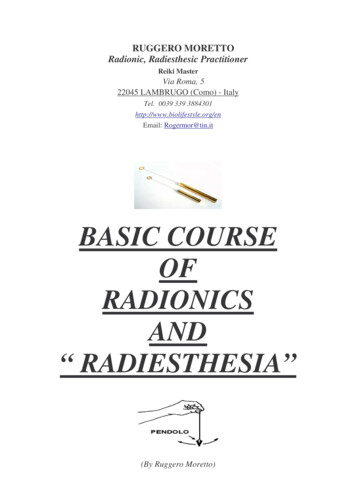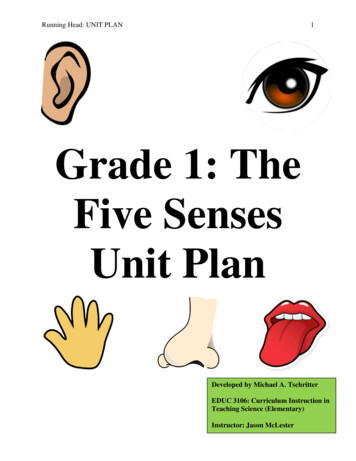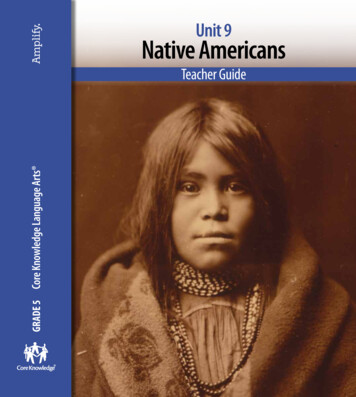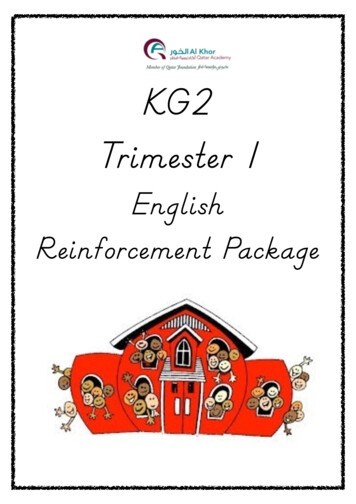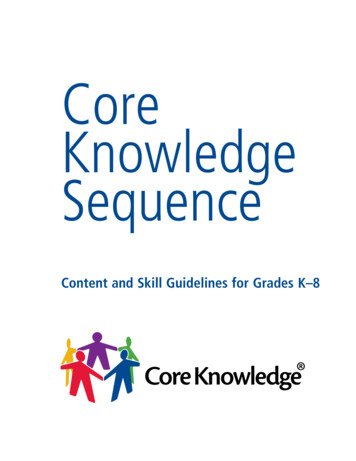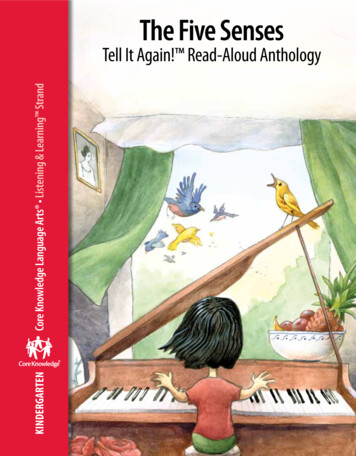
Transcription
KindergartenCore Knowledge Language Arts Listening & Learning StrandThe Five SensesTell It Again! Read-Aloud Anthology
The Five SensesTell It Again! Read-Aloud AnthologyListening & Learning StrandKindergartenCore Knowledge Language Arts
Creative Commons LicensingThis work is licensed under a Creative Commons AttributionNonCommercial-ShareAlike 3.0 Unported License.You are free:to Share — to copy, distribute and transmit the workto Remix — to adapt the workUnder the following conditions:Attribution — You must attribute the work in thefollowing manner:This work is based on an original work of the CoreKnowledge Foundation made available throughlicensing under a Creative Commons AttributionNonCommercial-ShareAlike 3.0 Unported License. Thisdoes not in any way imply that the Core KnowledgeFoundation endorses this work.Noncommercial — You may not use this work forcommercial purposes.Share Alike — If you alter, transform, or build upon thiswork, you may distribute the resulting work only underthe same or similar license to this one.With the understanding that:For any reuse or distribution, you must make clear toothers the license terms of this work. The best way todo this is with a link to this web 3.0/Copyright 2013 Core Knowledge Foundationwww.coreknowledge.orgAll Rights Reserved.Core Knowledge Language Arts, Listening & Learning,and Tell It Again! are trademarks of the Core KnowledgeFoundation.Trademarks and trade names are shown in this book strictlyfor illustrative and educational purposes and are the propertyof their respective owners. References herein should notbe regarded as affecting the validity of said trademarks andtrade names.
Table of ContentsThe Five SensesTell It Again! Read-Aloud AnthologyAlignment Chart for The Five Senses . . . . . . . . . . . . . . . . . . . . . . . . . . . . . . . . . . . . . . . . . . . . . . . . . . vIntroduction to The Five Senses . . . . . . . . . . . . . . . . . . . . . . . . . . . . . . . . . . . . . . . . . . . . . . . . . . . . . .1Lesson 1: My Senses Are Amazing. . . . . . . . . . . . . . . . . . . . . . . . . . . . . . . . . . . . . . . . . . . . . . . . . . . . 10Lesson 2: The Sense of Sight . . . . . . . . . . . . . . . . . . . . . . . . . . . . . . . . . . . . . . . . . . . . . . . . . . . . . . . 19Lesson 3: The Sense of Hearing . . . . . . . . . . . . . . . . . . . . . . . . . . . . . . . . . . . . . . . . . . . . . . . . . . . . . 30Lesson 4: The Sense of Smell. . . . . . . . . . . . . . . . . . . . . . . . . . . . . . . . . . . . . . . . . . . . . . . . . . . . . . . 39Lesson 5: The Sense of Taste . . . . . . . . . . . . . . . . . . . . . . . . . . . . . . . . . . . . . . . . . . . . . . . . . . . . . . . 50Lesson 6: The Sense of Touch. . . . . . . . . . . . . . . . . . . . . . . . . . . . . . . . . . . . . . . . . . . . . . . . . . . . . . . 61Pausing Point . . . . . . . . . . . . . . . . . . . . . . . . . . . . . . . . . . . . . . . . . . . . . . . . . . . . . . . . . . . . . . . 71Lesson 7: Ray Charles . . . . . . . . . . . . . . . . . . . . . . . . . . . . . . . . . . . . . . . . . . . . . . . . . . . . . . . . . . . 76Lesson 8: Helen Keller . . . . . . . . . . . . . . . . . . . . . . . . . . . . . . . . . . . . . . . . . . . . . . . . . . . . . . . . . . . 86Domain Review . . . . . . . . . . . . . . . . . . . . . . . . . . . . . . . . . . . . . . . . . . . . . . . . . . . . . . . . . . . . . . 95Domain Assessment. . . . . . . . . . . . . . . . . . . . . . . . . . . . . . . . . . . . . . . . . . . . . . . . . . . . . . . . . . . 97Culminating Activities . . . . . . . . . . . . . . . . . . . . . . . . . . . . . . . . . . . . . . . . . . . . . . . . . . . . . . . . 101Appendix . . . . . . . . . . . . . . . . . . . . . . . . . . . . . . . . . . . . . . . . . . . . . . . . . . . . . . . . . . . . . . . . . 103
Alignment Chart for The Five SensesThe following chart contains core content objectives addressed inthis domain. It also demonstrates alignment between the CommonCore State Standards and corresponding Core KnowledgeLanguage Arts (CKLA) goals.LessonsAlignment Chart for The Five Senses12345678Identify and describe the five senses: sight, hearing, smell, taste,and touch Identify the body parts associated with the five senses Describe the experiences and challenges of someone who is blindor deaf Explain the contributions of Ray Charles Core Content ObjectivesProvide simple explanations about how the eyes, ears, nose,tongue, and skin workDescribe how the five senses help people learn about their world Describe some ways people take care of their bodiesDescribe some ways the five senses help protect people fromharm Explain the contributions of Helen KellerReading Standards for Informational Text: KindergartenKey Ideas and DetailsSTD RI.K.1CKLAGoal(s)With prompting and support, ask and answer questions about key details in a text.With prompting and support, ask and answerquestions (e.g., who, what, where, when) requiringliteral recall and understanding of the details and/or facts of a nonfiction/informational read-aloud Answer questions that require makinginterpretations, judgments, or giving opinionsabout what is heard in a nonfiction/informationalread-aloud, including answering why questionsthat require recognizing cause/effect relationships The Five Senses Alignment Chart 2013 Core Knowledge Foundationv
LessonsAlignment Chart for The Five Senses123456 7STD RI.K.2With prompting and support, identify the main topic and retell key details of a text.CKLAGoal(s)With prompting and support, identify the maintopic and retell key details of a nonfiction/informational read-aloudsSTD RI.K.3With prompting and support, describe the connection between two individuals, events, ideas, or pieces ofinformation in a text.CKLAGoal(s)With prompting and support, describe theconnection between two individuals, events,ideas, or pieces of information in a nonfiction/informational read-aloud 8 Craft and StructureSTD RI.K.4With prompting and support, ask and answer questions about unknown words in a text.CKLAGoal(s)With prompting and support, ask and answerquestions about unknown words in nonfiction/informational read-alouds and discussions Integration of Knowledge and IdeasSTD RI.K.7With prompting and support, describe the relationship between illustrations and the text in which they appear(e.g., what person, place, thing, or idea in the text an illustration depicts).CKLAGoal(s)With prompting and support, describeillustrations from a nonfiction/informationalread-aloud, using the illustrations to check andsupport comprehension of the read-aloudSTD RI.K.9With prompting and support, identify basic similarities in and differences between two texts on the same topic(e.g., in illustrations, descriptions, or procedures).CKLAGoal(s)With prompting and support, compare andcontrast similarities and differences within asingle nonfiction/informational read-aloud orbetween two or more nonfiction/informationalread-alouds Range of Reading and Level of Text ComplexitySTD RI.K.10Actively engage in group reading activities with purpose and understanding.CKLAGoal(s)Actively engage in nonfiction/informational readaloudsviThe Five Senses Alignment Chart 2013 Core Knowledge Foundation
LessonsAlignment Chart for The Five Senses12345678Writing Standards: KindergartenText Types and PurposesSTD W.K.2Use a combination of drawing, dictating, and writing to compose informative/explanatory texts in which theyname what they are writing about and supply some information about the topic.CKLAGoal(s)Use a combination of drawing, dictating, andwriting to present information from a nonfiction/informational read-aloud, naming the topic andsupplying some details Research to Build and Present KnowledgeSTD W.K.8With guidance and support from adults, recall information from experiences or gather information fromprovided sources to answer a question.CKLAGoal(s)With assistance, categorize and organize factsand information within a given domain to answerquestions Speaking and Listening Standards: KindergartenComprehension and CollaborationSTD SL.K.1Participate in collaborative conversations with diverse partners about Kindergarten topics and texts with peersand adults in small and large groups.STD SL.K.1aFollow agreed-upon rules for discussions (e.g., listening to others and taking turns speaking about the topicsand texts under discussion).CKLAGoal(s)Use agreed-upon rules for group discussions,e.g., look at and listen to the speaker, raisehand to speak, take turns, say “excuse me” or“please,” etc.STD SL.K.1bContinue a conversation through multiple exchanges.CKLAGoal(s)Carry on and participate in a conversation overfour to five turns, stay on topic, initiate commentsor respond to a partner’s comments, with eitheran adult or another child of the same ageSTD SL.K.2Confirm understanding of a text read aloud or information presented orally or through other media by askingand answering questions about key details and requesting clarification if something is not understood.CKLAGoal(s)Ask and answer questions to clarify informationin a fiction or nonfiction/informational read-aloud Presentation of Knowledge and IdeasSTD SL.K.4Describe familiar people, places, things, and events and, with prompting and support, provide additional detail.CKLAGoal(s)Describe familiar people, places, things, andevents and, with prompting and support, provideadditional detail The Five Senses Alignment Chart 2013 Core Knowledge Foundationvii
LessonsAlignment Chart for The Five Senses12345STD SL.K.5Add drawings or other visual displays to descriptions as desired to provide additional detail.CKLAGoal(s)Add drawings or other visual displays todescriptions as desired to provide additionaldetailSTD SL.K.6Speak audibly and express thoughts, feelings, and ideas clearly.CKLAGoal(s)Speak audibly and express thoughts, feelings,and ideas clearly 6 78 Language Standards: KindergartenConventions of Standard EnglishSTD L.K.1Demonstrate command of the conventions of standard English grammar and usage when writing or speaking.STD L.K.1bUse frequently occurring nouns and verbs.CKLAGoal(s)Use frequently occurring nouns and verbs in orallanguageSTD L.K.1fProduce and expand complete sentences in shared language Answer questions orally in complete sentencesCKLAGoal(s)Produce and expand complete sentences inshared languageVocabulary Acquisition and UseSTD L.K.4Determine or clarify the meaning of unknown and multiple-meaning words and phrases based on Kindergartenreading and content.STD L.K.4aIdentify new meanings for familiar words and apply them accurately (e.g., knowing duck is a bird and learningthe verb to duck).CKLAGoal(s)Identify new meanings for familiar words andapply them accurately (e.g., knowing duck is abird and learning the verb to duck)STD L.K.5With guidance and support from adults, explore word relationships and nuances in word meanings.STD L.K.5aSort common objects into categories (e.g., shapes, foods) to gain a sense of the concepts the categoriesrepresent.CKLAGoal(s)Sort common objects into categories (e.g.,shapes, foods) to gain a sense of the conceptsthe categories representSTD L.K.5bDemonstrate understanding of frequently occurring verbs and adjectives by relating them to their opposites(antonyms).CKLAGoal(s)Demonstrate understanding of frequentlyoccurring verbs and adjectives by relating themto their opposites (antonyms)viiiThe Five Senses Alignment Chart 2013 Core Knowledge Foundation
LessonsAlignment Chart for The Five Senses12345678STD L.K.5cIdentify real-life connections between words and their use (e.g., note places at school that are colorful).CKLAGoal(s)Identify real-life connections between words andtheir use (e.g., note places at school that arecolorful)STD L.K.5dDistinguish shades of meaning among verbs describing the same general action (e.g., walk, march, strut,prance) by acting out the meanings.CKLAGoal(s)Distinguish shades of meaning among verbsdescribing the same general action (e.g., walk,march, strut, prance) by acting out the meaningsSTD L.K.6Use words and phrases acquired through conversations, reading and being read to, and responding to texts.CKLAGoal(s) Use words and phrases acquired throughconversations, being read to, and responding totextsLearn the meanings of common sayings andphrases Additional CKLA GoalsListen to and understand a variety of texts, including informationaltextPrior to listening to an informational read-aloud, identify orallywhat they know about a given topicWhile listening to an informational read-aloud, orally predict whatwill happen next in the read-aloud based on the pictures and/ortext heard thus far, and then compare the actual outcome to thepredictionExplain that “Ray Charles” and “Helen Keller” are realistic textsbecause they are biographies of the lives of Ray Charles andHelen Keller These goals are addressed in all lessons in this domain. Rather than repeat these goals as lessonobjectives throughout the domain, they are designated here as frequently occurring goals.The Five Senses Alignment Chart 2013 Core Knowledge Foundationix
Introduction to The Five SensesThis introduction includes the necessary background informationto be used in teaching the The Five Senses domain. The Tell ItAgain! Read-Aloud Anthology for The Five Senses contains eightdaily lessons, each of which is composed of two distinct parts,so that the lesson may be divided into smaller chunks of time andpresented at different intervals during the day. Each entire lessonwill require a total of fifty minutes.This domain includes a Pausing Point following Lesson 6, after allof the senses have been introduced. At the end of the domain, aDomain Review, a Domain Assessment, and Culminating Activitiesare included to allow time to review, reinforce, assess, andremediate content knowledge. You should spend no more thantwelve days total on this domain.Week One# Day 1Day 2Day 4Day 5Lesson 1A: “My SensesAre Amazing” (35 min.)Lesson 2A: “The Senseof Sight” (35 min.)Lesson 3A: “The Senseof Hearing” (35 min.)Lesson 4A: “The Senseof Smell” (35 min.)Lesson 5A: “The Sense ofTaste” (35 min.)Lesson 1B: Extensions(15 min.)Lesson 2B: Extensions(15 min.)Lesson 3B: Extensions(15 min.)Lesson 4B: Extensions(15 min.)Lesson 5B: Extensions(15 min.)50 min.50 min.50 min.50 min.50 min.Day 8Day 9Day 10Lesson 7A: “Ray Charles”(35 min.)Lesson 8A: “Helen Keller”(35 min.)Domain ReviewLesson 7B: Extensions(15 min.)Lesson 8B: Extensions(15 min.)50 min.50 min.Day 3#Week TwoDay 6Lesson 6A: “The Senseof Touch” (35 min.)#Day 7Pausing PointLesson 6B: Extensions(15 min.)50 min.50 min. 50 min.Week ThreeDay 11Day 12Domain AssessmentCulminating Activities50 min.50 min. Lessons include Student Performance Task Assessments# Lessons require advance preparation and/or additional materials; please plan aheadThe Five Senses Introduction 2013 Core Knowledge Foundation1
Domain ComponentsAlong with this anthology, you will need: Tell It Again! Media Disk or the Tell It Again! Flip Book for TheFive Senses Tell It Again! Image Cards for The Five Senses Tell It Again! Supplemental Guide for The Five Senses Tell It Again! Multiple Meaning Word Posters for The Five SensesRecommended Resource: Core Knowledge Kindergarten Teacher Handbook, edited byE.D. Hirsch, Jr. and Souzanne A. Wright (Core KnowledgeFoundation, 2004) ISBN: 978-1890517694Why The Five Senses Are ImportantThe color of the sky, the sound of a dog barking, the scent ofa rose, the taste of chocolate cake, the feel of a cool breeze—everything that we know about the world comes to us through ourfive senses. Humans gather information about their environmentthrough the use of sight, hearing, smell, taste, and touch. Each ofthe five senses responds to specific stimuli in the world aroundus, and each uses a unique part of the body to take in information.This domain will be one of many that will follow in subsequentgrade levels in which students will broaden their knowledge of thehuman body. An exploration of the senses also requires studentsto make observations and then use language to describe thoseobservations, both of which are key skills in the scientific process.Later lessons will also address what happens if the senses ofsight and hearing do not function properly. Students will hearinspirational stories about the lives of two individuals, Ray Charlesand Helen Keller, who overcame very significant challenges posedby disabilities related to sight and hearing.2The Five Senses Introduction 2013 Core Knowledge Foundation
Core Vocabulary for The Five SensesThe following list contains all of the core vocabulary words in TheFive Senses in the forms in which they appear in the read-aloudsor, in some instances, in the “Introducing the Read-Aloud” sectionat the beginning of the lesson. Boldfaced words in the list havean associated Word Work activity. The inclusion of the words onthis list does not mean that students are immediately expected tobe able to use all of these words on their own. However, throughrepeated exposure throughout the lessons, they should acquirea good understanding of most of these words and begin to usesome of them in conversation.Lesson 1amazingharmsightsmelltastetouchLesson 2irisleapprotectpupilLesson 3echoinvisiblesound wavesvibratevolumeLesson 4Lesson 7moleculesmucusnostrilsscentssmell receptorsLesson 5congestedflavorfulpuckersalivataste son 8deafdisobedientfrustratedsensationsLesson 6nervessensitiveskintextureThe Five Senses Introduction 2013 Core Knowledge Foundation3
Student Performance Task AssessmentsIn the Tell It Again! Read-Aloud Anthology for The Five Senses,there are numerous opportunities to assess students’ learning.These assessment opportunities range from informal observations,such as Think Pair Share and some Extension activities, to moreformal written assessments. These Student Performance TaskAssessments (SPTA) are identified in the Tell It Again! Read-AloudAnthology with this icon: . There is also an end-of-domainsummative assessment. Use the Tens Conversion Chart locatedin the Appendix to convert a raw score on each SPTA into a Tensscore. On the same page, you will also find the rubric for recordingobservational Tens Scores.Above and BeyondIn the Tell It Again! Read-Aloud Anthology for The Five Senses,there are numerous opportunities in the lessons and the PausingPoint to challenge students who are ready to attempt activitiesthat are above grade-level. These activities are labeled “Above andBeyond” and are identified with this icon: .Supplemental GuideAccompanying the Tell It Again! Read-Aloud Anthology is aSupplemental Guide designed specifically to assist educatorswho serve students with limited English oral language skills orstudents with limited home literary experience, which may includeEnglish Language Learners (ELLs) and children with special needs.Teachers whose students would benefit from enhanced orallanguage practice may opt to use the Supplemental Guide as theirprimary guide in the Listening & Learning Strand. Teachers mayalso choose to begin a domain by using the Supplemental Guideas their primary guide before transitioning to the Tell It Again!Read-Aloud Anthology, or may choose individual activities fromthe Supplemental Guide to augment the content covered in the TellIt Again! Read-Aloud Anthology.The Supplemental Guide activities that may be particularly relevantto any classroom are the Multiple Meaning Word Activities and4The Five Senses Introduction 2013 Core Knowledge Foundation
accompanying Multiple Meaning Word Posters, which helpstudents determine and clarify different meanings of words;Syntactic Awareness Activities, which call students’ attention tosentence structure, word order, and grammar; and VocabularyInstructional Activities, which place importance on buildingstudents’ general academic, or Tier 2, vocabulary. These activitiesafford all students additional opportunities to acquire a richerunderstanding of the English language. Several of these activitieshave been included as Extensions in the Tell It Again! Read-AloudAnthology. In addition, several words in the Tell It Again! ReadAloud Anthology are underlined, indicating that they are multiplemeaning words. The accompanying sidebars explain some of themore common alternate meanings of these words. SupplementalGuide activities included in the Tell It Again! Read-Aloud Anthologyare identified with this icon: .Recommended Resources for The Five SensesTrade Book ListThe Tell It Again! Read-Aloud Anthology includes a number ofopportunities in Extensions, the Pausing Point, and the andCulminating Activities for teachers to select trade books from thislist to reinforce domain concepts through the use of authenticliterature. In addition, teachers should consider other timesthroughout the day when they might infuse authentic domainrelated literature. If you recommend that families read aloud withtheir child each night, you may wish to suggest that they choosetitles from this trade book list to reinforce the domain concepts.You might also consider creating a classroom lending library,allowing students to borrow domain-related books to read at homewith their families.1.Bee-bim Bop! by Linda Sue Park (Sandpiper, Houghton MifflinHarcourt, 2005) ISBN 978-05470767132.Brian’s Bird, by Patricia Anne Davis (Whitman, 2000) ISBN978-08075088173.A Button in Her Ear, by Ada B. Litchfield (Albert Whitman &Company, 1976) ISBN 978-0807509876The Five Senses Introduction 2013 Core Knowledge Foundation5
4.Eating Well, by Liz Gogerly (Crabtree Publishing Company,2009) ISBN 978-07787411765.Eyes (Human Body), by Robert James (Rourke Publishing,1995) ISBN 978-15710310446.First Delights: A Book About the Five Senses, by Tasha Tudor(Price, Stern, Sloan, 1988) ISBN 978-04480932777.The Five Senses (It’s Science), by Sally Hewitt (Scholastic,2002) ISBN 978-0516238238.The Five Senses: Hearing, by Maria Ruis (Barron’s EducationalSeries, Inc., 1985) ISBN 978-08120356369.The Five Senses: Sight, by Maria Rius (Barron’s EducationalSeries, Inc., 1985) ISBN 978-081203564310. The Five Senses: Smell, by Maria Rius (Barron’s EducationalSeries, Inc., 1985) ISBN 978-081203565011. The Five Senses: Taste, by Maria Rius (Barron’s EducationalSeries, Inc., 1985) ISBN 978-081203566712. The Five Senses: Touch, by Maria Rius (Barron’s EducationalSeries, Inc., 1985) ISBN 978-081203567413. Fuel the Body: Eating Well, by Amanda Doering Tourville(Picture Window Books, 2008) ISBN 978-140484814614. Get Up and Go!, by Nancy Carlson (Penguin Group, 2008) ISBN978-014241064615. Go Wash Up: Keeping Clean, by Amanda Doering Tourville(Coughlan Publishing, 2008) ISBN 978-140484808516. Green Start: The Five Senses, by Ikids (Innovative Kids, 2009)ISBN 978-158476812817. Hanni and Beth: Safe and Sound, (Blue Marlin, 2007)978-097929180718. Happy Birthday Moon, by Frank Asch (Aladdin, 2000) ISBN978-068983544519. Hearing, by Katie Dicker (M. Evans and Company, 2009) ISBN978-023753600820. Hearing (I Know That!), by Claire Llewellyn (Franklin Watts,2009) ISBN 978-074968895021. Hearing Things, by Allan Fowler (Childrens Press, Inc., 1991)ISBN 978-05164490986The Five Senses Introduction 2013 Core Knowledge Foundation
22. The Hickory Chair, by Lisa Rowe Fraustino (Arthur LevineBooks, 2001) ISBN 978-059052248923. It Looked Like Spilt Milk, by Charles Shaw (HarperFestival,1992) ISBN 978-006443312924. Kami and the Yaks, by Andrea Stenn Stryer (Bay Otter Press,2007) ISBN 978-097789610325. The Listening Walk, by Paul Showers and Aliki (HarperCollins,1993) ISBN 978-006443322826. Look! A Book About Sight, by Dana Meachen Rau (PictureWindow Books, 2005) ISBN 978-140481019827. Look, Listen, Taste, Touch, and Smell: Learning About Your FiveSenses, by Hill Nettleton (Picture Window Books, 2006) ISBN978-140480508828. Looking Out for Sarah, by Glenna Lang (Charles Bridge, 2001)ISBN 978-157091607629. Mandy Sue Day, by Roberta Karim (Clarion, 1994) ISBN978-061831675530. Mice Squeak, We Speak, by Arnold L. Shapiro and illustrated byTomie dePaola (Puffin, 2000) ISBN 978-069811873731. Moses Goes to a Concert, by Isaac Millman (Farrar Straus,1998) ISBN 978-037445366432. My Amazing Body: A First Look at Health and Fitness, byPat Thomas (Barron’s Educational Series, Inc., 2001) ISBN978-076412119733. My Five Senses, by Aliki (HarperFestival, 1991) ISBN978-044084354234. My Senses Help Me, by Bobbie Kalman (Crabtree PublishingCompany, 2010) ISBN 978-077879472135. No One Saw: Ordinary Things Through the Eyes of an Artist, byBob Raczka (Millbook Press, 2001) ISBN 978-076131648036. Oh, the Things You Can Do that Are Good for You!: All AboutStaying Healthy, by Tish Rabe (Random House, Inc., 2001)ISBN 978-037581098537. Polar Bear, Polar Bear, by Bill Martin Jr. (Henry Holt and Co.,2010) ISBN 978-0805092455The Five Senses Introduction 2013 Core Knowledge Foundation7
38. Rainbow Joe and Me, by Maria Diaz Strom (Lee and LowBooks, 1999) ISBN 978-158430050239. Screaming Kind of Day, by Rachna Gilmore (Fitzhenry &Whiteside, 1999) ISBN 978-155041661940. Seeing, by Katie Dicker (M. Evans and Company, 2011) ISBN978-023754448541. Seven Blind Mice, by Ed Young (Puffin Books, 2002) ISBN978-069811895942. Shhhh . . . A Book About Hearing, by Dana Meachen Rau(Picture Window Books, 2005) ISBN 978-140481018143. Sight, by Annalise Bekkering (Weigl Publishers, Inc., 2009) ISBN978-160596053144. Sign Language, by Lora Heller (Sterling Children’s Books, 2012)ISBN 978-140276392245. Sleep Is for Everyone (Let’s-Read-and-Find-out ScienceBook), by Paul Showers (HarperCollins Publishers, 1997) ISBN978-006445141346. Smelling and Tasting (I Know That!ng), by Claire Llewellyn(Orchard/Watts Group, 2004) ISBN 978-074965726047. Tasting and Smelling, by Katie Dicker (M. Evans and Company,2011) ISBN 978-023754449248. Touching (I Know That!), by Claire Llewellyn (Franklin Watts,2009) ISBN 978-074968897449. Touching and Feeling, by Katie Dicker (M. Evans and Company,2011) ISBN 978-023754450850. What is Taste?, by Jennifer Boothroyd (Lerner Classroom, 2009)ISBN 978-076135017051. You Can’t Smell a Flower with Your Ear! All About Your 5Senses, by Joanna Cole (Penguin Young Readers, 1994) ISBN978-044840469152. You Can’t Taste a Pickle with Your Ear: A Book About Your 5Senses, by Harriet Ziefert and illustrated by Amanda Haley(Blue Apple, 2002) ISBN 978-192976668053. Your Five Senses, by Melvin and Gilda Berger (Scholastic, 2003)ISBN 978-04395668898The Five Senses Introduction 2013 Core Knowledge Foundation
Websites and Other ResourcesStudent Resources1.The Brain and .uk/interactives/science/brainandsenses2.Five Senses Gamehttp://pbskids.org/sid/isense.html3.Five Senses Jivehttp://pbskids.org/mamamirabelle/funstuff videos five senses jive.html4.Flush the Unhealthy Food .Guide Dogs eedom-guide-dogs-for-kids6.Sense of e.html7.Sign ndex.html8.Unite for acher Resources9.United States Department of Health and Human Serviceshttp://www.hhs.gov10. Helen Kellerhttp://www.afb.org/section.aspx?SectionID 1&TopicID 19411. Ray sodes/ray-charles/about-ray-charles/554The Five Senses Introduction 2013 Core Knowledge Foundation9
My Senses Are Amazing1 Lesson ObjectivesCore Content ObjectivesStudents will: Identify the five senses: sight, hearing, smell, taste, and touch Identify the body parts associated with the five senses Describe how the five senses help people learn about their world Describe some ways the five senses protect people from harmLanguage Arts ObjectivesThe following language arts objectives are addressed in thislesson. Objectives aligning with the Common Core StateStandards are noted with the corresponding standard inparentheses. Refer to the Alignment Chart for additional standardsaddressed in all lessons in this domain.Students will: With prompting and support, describe an illustration of the fivesenses and use illustrations that accompany “My Senses AreAmazing” to check and support understanding of the read-aloud(RI.K.7) Present information about the five senses by using acombination of drawing, dictating, and writing (W.K.2) With assistance, categorize information about the sense of lighton a chart [IM 1C-1] (W.K.8) With prompting and support, describe familiar things, such asthe five senses, and provide additional details (SL.K.4) Provide additional detail about the five senses by addingdrawings to descriptions of the five senses (SL.K.5)10The Five Senses: 1 My Senses Are Amazing 2013 Core Knowledge Foundation
Sort common objects into categories such as sight, hearing,smell, taste, and touch to gain a sense of the concepts thecategories represent (L.K.5a) Listen to a variety of texts, including informational text such as“My Senses Are Amazing”Core Vocabularyamazing, adj. Surprisingly good, causing wonderExample: It was amazing when the magician made a coin disappearright before my eyes!Variation(s): noneharm, n. An injury to your bodyExample: My baby sister always pulls my hair, but I know she doesn’tmean any harm.Variation(s): nonesight, n. The act of seeing and looking at things with your eyesExample: Sight is my favorite sense because I love seeing the differentcolors all around me.Variation(s): nonesmell, v. To detect odors with your noseExample: I love to smell the grass right after my mom mows the lawn.Variation(s): smells, smelled, smellingtaste, v. To detect flavors with your tongueExample: D
Trademarks and trade names are shown in this book strictly for illustrative and educational purposes and are the property . places, things, and events and, with prompting and support, provide additional detail. CKLA . These goals are addressed in all lessons




